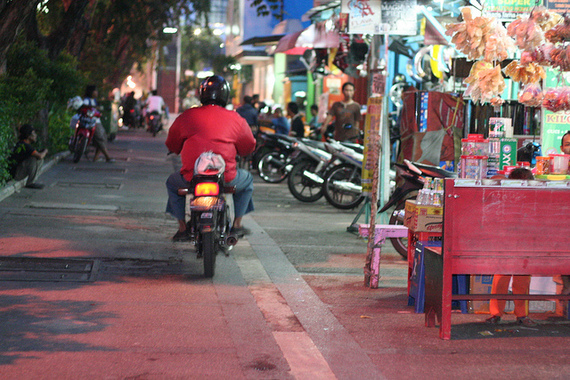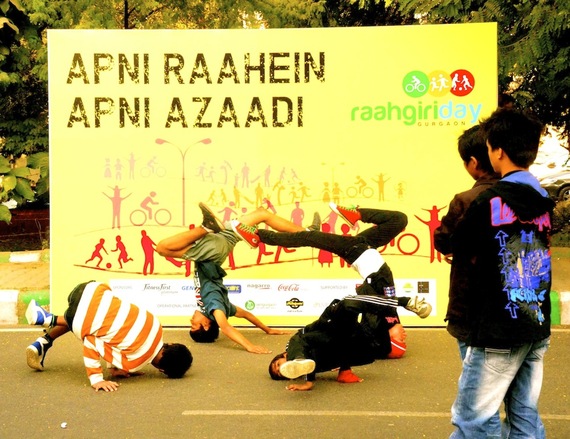By Adèle Charbonneau
Walking makes citizens fully part of the city and of the urban space. As one article in the City Fix presented it, "Walking is one of the most democratic and equitable ways of getting around, but it's also one of the ways most linked to factors outside an individual's control, like social or physical abilities and the presence of infrastructure to walk comfortably and safely." Developing cities are often characterized by limited walking infrastructure (absence of sidewalks, holes etc). Yet, efforts are being made to change the situation. Read about four cities in Asia and Africa that are promoting walkability.
According to Widya Anggraini, only a few cities in Indonesia pay attention to a walking culture among residents. This is reflected through the poor quality of the pavement in many cities, including Surabaya. Moreover, the hot weather entices people into owning private vehicles such as motorcycles and cars. As a result, civilians are seldom found walking in Surabaya. There is increasing awareness among the public regarding the absence of walking culture, which spurred an idea to form a walking program called Manic Street Walkers (MSW). This community invites residents to take pleasure in walking by exploring the city. The around-the-city walking tour activity is done at least twice a month with varying themes, such as history, old villages, Chinatown, Arabic villages, and others. In recent years, the SCG has made many improvements on sidewalks and waterways. Pavements now use marble, are wider in size, and are more elevated to prevent motorcycles from taking over.
In Delhi, Mukta Naik presents the car-free streets movement, inspired by Bogota's "Ciclovia." Started in 2011, it became larger when Raahgiri Foundation tied up with the New Delhi Municipal Corporation to replicate the effort in Connaught Place, the central business district of one of the world's largest cities in July 2014. In founding Raahgiri, EMBARQ India partnered with Heritage School; I am Gurgaon, the Aravalli Biodiversity Park; recreational sports league organizer Duplays and cycling enthusiasts' group Pedal Yatri; and the Haryana Police. These organizations were driven by a larger vision, one that involved healthy lifestyles, safe public spaces, an integration of nature into the city and social inclusion. The tremendous turn-outs at Delhi's Raahgiri - approximately 10,000 people every Sunday - is being seen as a resounding support for non-motorized transportation and active lifestyles. Raahgiri has also begun to change opinions of shop owners and traders in the area who had been fiercely opposed to the idea.
In collaboration with the Asian Development Bank (ADB), the Work for Better Bangladesh Trust (WBB) initiated thorough research on mobility in Dhaka. WBB took on initiatives to work on the results and promote walking as well as improve the overall pedestrian environment. It staged public campaigns to encourage people to choose walking as their mode of transport more often. Based on the results, Dhaka North City Corporation (DNCC) will also incorporate policies to improve the walking environment. The plan includes accommodating pedestrians without vehicles as an obstruction and reduces pedestrian-vehicle intersections, increases shade cover to provide protection from the sun (as well as rain by planting long-leaf or broad-leaf trees), ensures visibility of pedestrians at night by putting LED lights in short intervals, and eliminates mobility barriers for pedestrians with physical disabilities. In the opinion of Sumaiya Nehla Saif, if implemented more broadly, this project has immense future potential to help improve the road situation in Dhaka.
The Transit Oriented Development strategy of the City of Johannesburg is producing a series of interventions intended to ease vehicular traffic and increase pedestrian safety. A new pedestrian bridge or "skywalk" is currently planned over one of the urban corridors. The bridge's design, however, raises many questions for Tariq Toffa, about the comprehensiveness of the approach, especially with regard to existing pedestrian and social infrastructure. Its long, non-descript ramps afford little consideration for pedestrian behavioral patterns, which currently exist. Moreover, minibus taxis, which stop at the corner, do not seem to have been included in the design in any significant way either, thereby promising to further, rather than ameliorate, congestion. Despite the above concerns, what gives cause for optimism is that in the community feedback meeting on the proposed design: residents of the area flatly rejected the rationale for the bridge as a starting point and requested a review of the project by the JDA.
These articles presented initiatives from around the world to promote alternative means of transport in cities. Check out more of the discussion on transportation on URB.im and contribute to the debate.
Photo credit: Manic Street Walkers and Raahgiri

